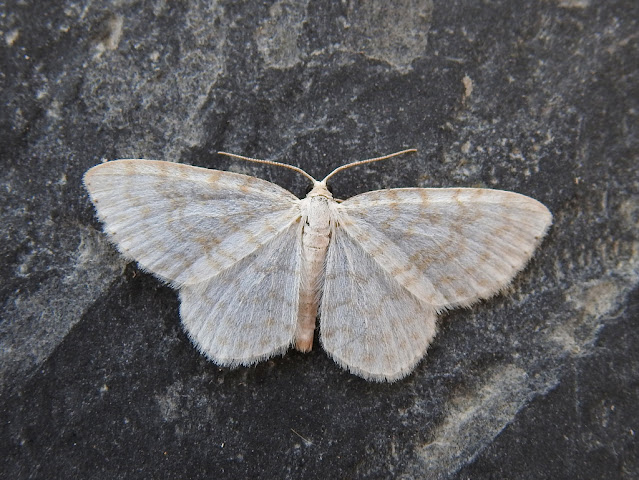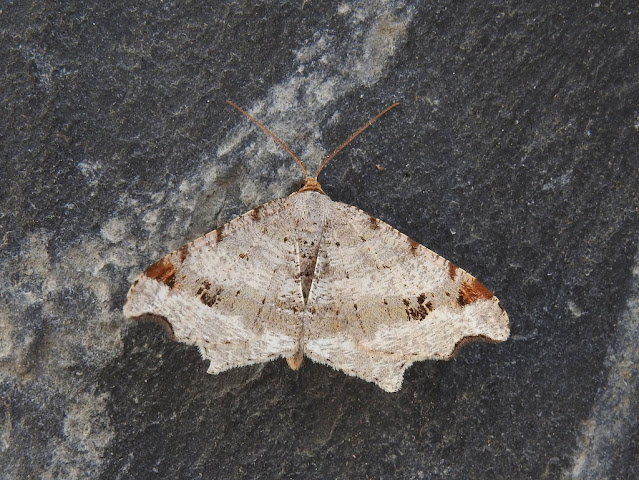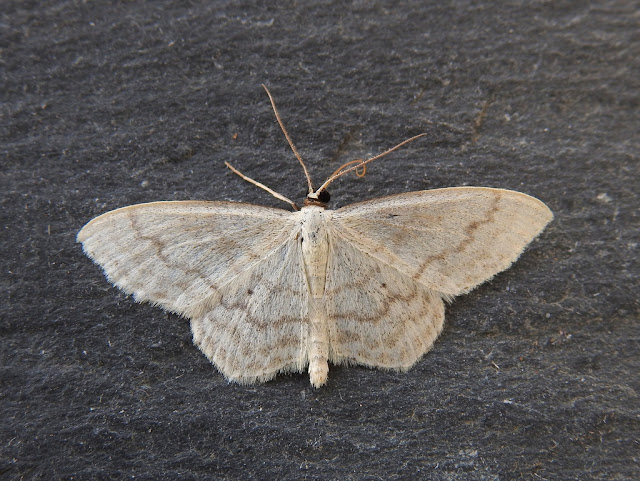Many times, over the years, various friends suggested I get into mothing. As
recently as spring 2022 in fact. My reply was always the same: 'Maybe in
another life.' Knowing my own nature, I was convinced it would be impossible
to dabble at moths. Mothing would not be some pleasant summertime diversion.
No, it would be full-on, all-consuming, and I would become its slave.
I was not wrong.
Last year was bad enough, but this year is even worse. Or do I mean better?
Last June I would have to look up almost every single moth I caught. Initially
I had to ignore most micros - there just wasn't the time. One year on, and I
can identify most macros I catch, and micros get the attention they deserve.
I've taken to photographing many of them, and annotating each pic with the
moth's systematic classification, name (scientific and vernacular) and larval
food. It's a bit of a chore, but with a purpose - slowly I am beginning to
memorise a few.
The garden list is growing - 13 new in the last three nights - and the year
list is now on 162, plus five aggregates. Lots of rarity buzz too, with some
very decent records. And I now realise the blog is going to be my illustrated
mothing diary. So here we go...
Tuesday night

|
First Maiden's Blush of the year. Delicate and pristine.
|

|
Though its left forewing is a bit deformed, this
Scalloped Hazel is a first for the garden, so gets a
well-deserved mugshot.
|

|
Small White Wave - another garden first.
|

|
Sharp-angled Peacock. First of the year.
|

|
First for the garden.
|
Wednesday night

|
Sycamore. Not rare, but nice. Caught three last year.
|

|
The garden's second Cream Wave. More strongly marked than the
first, which featured in the previous post.
|

|
Just a single Bridport area dot on the Living Record map, but have
caught this moth two nights on the trot now, with two individuals last
night.
|

|
This outrageous micro was a very unexpected turn-up two nights ago. I
have seen countless photos on Twitter, but all from daytime encounters.
I didn't know it came to light as well, but it does. In fact, three did
last night! Affectionately known as Geoff.
|

|
Second Freyer's Pug of the year. Always look at pugs.
|

|
Another garden first, and seemingly quite a scarce moth in the county.
|

|
Side view, showing the little scale tufts.
|

|
Living Record map of Luquetia lobella. A good record for West Dorset.
|

|
Typical mothy 'little brown job', with beautifully intricate markings
when you look closely. Had a handful of these last year. This one is the
first of 2023.
|

|
Wednesday night's other Geoff.
|
Thursday night

|
First of the year. Caught a couple in 2022.
|

|
What a beauty! This Silver-ground Carpet is another garden
first.
|

|
This moth - another garden first - was netted by our wildlife hedge.
There don't appear to be that many Dorset records. Apparently it doesn't
come to light, though will come to pheremone lures designed to attract
its congener Grapholita funebrana, the Plum Fruit Moth. The two species look very similar, but I
am given to understand that the pale, off-white palps separate
tenebrosana from funebrana.
|
 |
No recent Bridport area records of G. tenebrosana, and only a total of nine elsewhere.
|
 |
First of the year. A cracking little micro.
|
 |
Straw Dot. First of the year, and a nice, fresh example of this common moth. It is about the same size and shape as Anania crocealis pictured above. Yet this one is a so-called 'macro-moth', and the other a 'micro'. Moths are tricky.
|
 |
To the naked eye this looks like a speckly little red-brown job. But through a lens it is STUNNING! First for the garden.
|
 |
This little cracker is only about 4.5mm long, and in almost perpetual motion. No way could I let it out of the pot! A great story with this moth too. See below...
|
So, Lyonetia prunifoliella. I knew it was a moth I hadn't seen before, but it reminded me of Lyonetia clerkella, a miniscule silvery splinter that I've encountered quite a few times now. Very quickly I located a good candidate in my copy of Manley. But hang on, that can't be the one - it says Lyonetia prunifoliella is categorised RDB1 (Red Data Book 1), i.e. endangered. Well, it was. Apparently not reliably recorded in the UK since 1900, it suddenly reappeared around 2017 and now several counties have recorded it a few times, including Dorset, with around ten records. Still a great catch though!
Perhaps it is obvious why I am hooked on this fascinating pastime.























I have to say, your photos are superb! Does your camera allow you to send photos to your lap-top or phone?
ReplyDeleteAh, thanks for that. Yes, it may not give DSLR quality, but the P900 does well, and as long as there is enough light to allow low ISO (ideally 100) I can usually get something I'm happy with. I can send photos direct to the phone, but usually I download to laptop, and tinker with them a bit. Or a lot. 😄
DeleteCheers Gavin. I may need to buy a new camera, mine is about 14-15 years old, although I tend just to use my phone these days. Not getting good results, particularly with micros.
ReplyDelete